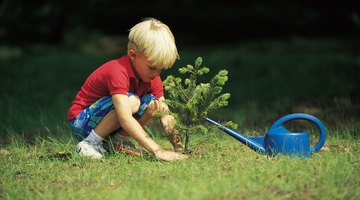What Is a Drain Spade?
Though used interchangeably, the terms “shovel” and “spade” refer to very different tools. A shovel’s wide, concave blade is angled to scoop loose material while the blade of a spade extends in a straight line from the handle, designed for digging.

The long, narrow drain spade, also called a sharp shooter, has aided farmers and gardeners for more than a century.
Uses
A report published in 1871 by the Highland and Agricultural Society of Scotland, Edinburgh describes the original purpose of the drain spade: digging and cleaning narrow deep ditches to drain marshy land as a way to improve it for agricultural purposes. Today, this straight, narrow spade is also called a sharp shooter because it enables you to dig deep, precisely-placed postholes for fences, to create trenches for laying pipe or wire underground and to transplant small trees and shrubs into or out of close-growing vegetation without damaging the root systems of surrounding plants.
About the Blade
The blade or digging end of the drain spade consists of a long, narrow rectangle of carbon or stainless steel. Stainless steel is more expensive, but does not rust. Blade widths range from four and three-quarters to six inches, while lengths are 14 or 16 inches. The blade’s “business” end is rounded or pointed and should be sharp to improve ease of insertion when digging. A drain spade blade made of stamped steel costs less while a forged steel blade provides better durability because the forging process makes the steel stronger by altering its grain pattern.
About the Handle
Manufacturers offer drain spades with handles made of steel, fiberglass or ash hardwood. Steel, the most durable handle material, is also the heaviest. Use gloves to prevent getting blisters if your drain spade has a fiberglass handle. Different handle lengths are available to encourage ergonomic comfort, based on your height and the tightness of the areas in which you plan to use it. Short handles measure 28 to 30 inches; long handles measure 47 to 48 inches. Straight, T-, D- or YD-shaped grips let you find the one giving you the best control and most comfort.
Other Considerations
Called treads or steps, small platforms on the shoulders of the drain spade’s blade aid in exerting more force when digging. The tread may be narrow or deep and face forward or back. The back of a drain spade’s blade may be “hollow” — revealing the indented shape of the blade as it joins the handle — or “closed” by a steel plate welded over the shaped area. A closed back spade resists soil buildup better than a hollow back spade, helpful if digging in wet, sticky soil. The strongest blade-to-handle connections use straps that run inside the handle. Other drain spades connect blade to handle using a socket, with or without a holding rivet or bolt. Replacing a broken handle may be easier on a socketed spade.
References
Resources
Writer Bio
Based in Texas, Catherine Hudgins began writing medical, technical, real-estate, travel and pet-care articles in 2000. Her articles have appeared in magazines such as “Food & Leisure," “MDNews,” and “CollegeBound." Hudgins received her Bachelor of Arts in fine art and Spanish from Trinity University.
Photo Credits
- Comstock/Comstock/Getty Images
- Comstock/Comstock/Getty Images
More Articles



